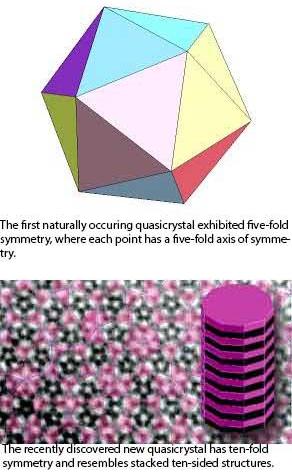Mar 18 2015
A joint research team from Princeton University and the University of Florence have announced the discovery of a 4.5 billion year old quasicrystal in a meteorite from an isolated region in Russia.
 The top panel shows the symmetry of the first natural quasicrystal, icosahedrite. The lower panel shows the symmetry of the recently discovered quasicrystal, which has not yet been named. (Credit: Source: Paul Steinhardt Et Al.)
The top panel shows the symmetry of the first natural quasicrystal, icosahedrite. The lower panel shows the symmetry of the recently discovered quasicrystal, which has not yet been named. (Credit: Source: Paul Steinhardt Et Al.)
This is the second natural quasicrystal ever to be discovered. The first natural quasicrystal was discovered by the team back in 2009. Prior to this discovery, most researchers believed that the structures were energetically unsteady and too delicate to be created in a natural manner.
"The finding of a second naturally occurring quasicrystal confirms that these materials can form in nature and are stable over cosmic time scales," said Paul Steinhardt, Princeton's Albert Einstein Professor of Science and a professor of physics, who led the study with Luca Bindi of the University of Florence.
According to Steinhardt, the finding of the second quasicrystal gives rise to the prospect that other quasicrystal types can be naturally created. The features of the quasicrystals include low friction, high level of hardness, and lack of heat conduction, thereby making them ideal options for applications like protective coatings on products from non-stick cookware to airplanes.
Yet to be given a name, the new quasicrystal possesses a structure which is similar to the stacking of flat 10-sided disks in a column. It is impossible to find such a structure in common crystals where the atoms are arranged tightly together in a systematic and repeated manner.
To clearly understand the difference between quasicrystals and common crystals, an example of a tiled floor can be considered. Six-sided hexagons tiles will fit precisely against each other to span the whole floor; however a five-sided pentagon or 10-sided decagon tiles placed next to each will have gaps between the tiles.
"The structure is saying 'I am not a crystal, but on the other hand, I am not random either,'" Steinhardt said.
Earlier crystals with unusual and unknown symmetries were created in the laboratory until 2009 when Bindi, Steinhardt, Nan Yao of Princeton and Peter Lu of Harvard announced the discovery of the first natural quasicrystal – icosahedrite. This was discovered in a rock that was found several years ago in Chukotka, Russia.
To verify the authenticity that the five-fold symmetric quasicrystal was certainly natural in origin, in 2011 Steinhardt and a group consisting of scientists and geologists from the Russian Academy of Sciences traveled to the place of origin to procure further samples which were then tested at the Smithsonian Museum in Washington, DC, the California Institute of Technology, the University of Florence and the Princeton Institute for the Science and Technology of Materials (PRISM) Imaging and Analysis Center.
The group established the theory that the quasicrystal was natural and from an extraterrestrial body which had formed about 4.57 billion years ago (same time the solar system was formed). They published the findings in the Proceedings of the National Academy of Sciences in 2012.
Bringing back the material and showing that it was of natural origins was an important scientific barrier to overcome.
Paul Steinhardt, Princeton's Albert Einstein Professor of Science
The latest quasicrystal discovery contains different grains although from the same meteorite. It has a 10-fold, or decagonal symmetry. It comprises nickel, aluminum, and iron, which in most cases are not found collectively in the same mineral due to the fact that aluminum tends to bind swiftly to oxygen, thereby blocking attachment to nickel and iron.
Currently the researchers are involved in studying how the mineral formed, "We know there was a meteor impact, and that the temperature was around 1000 to 1200 degrees Kelvin, and that the pressure was a hundred thousand times greater than atmospheric pressure, but that is not enough to tell us all the details," Steinhardt said.
We'd like to know whether the formation of quasicrystals is rare or is fairly frequent, how it occurs, and whether it could happen in other solar systems. What we find out could answer basic questions about the materials found in our universe.
Paul Steinhardt, Princeton's Albert Einstein Professor of Science
The research findings were published the journal Scientific Reports.